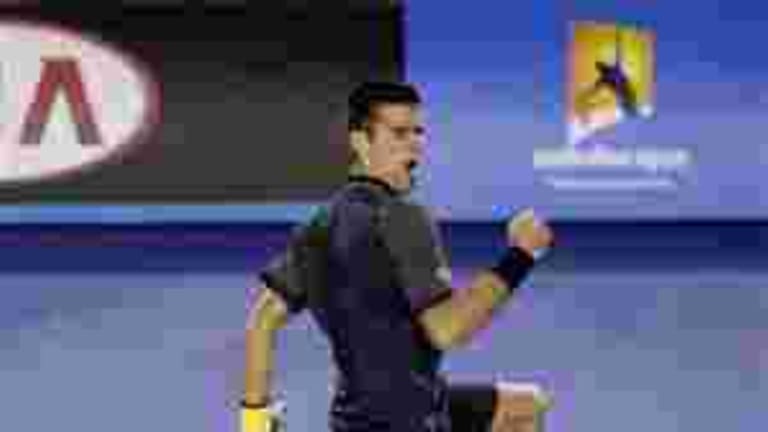MELBOURNE—The first question is: Where do we start? The length, the stats, the twists and turns, the comebacks and chokes, the backhand bombs and skidding gets, the botched drop shots and challenges not made, and the long fifth set that appeared to leave both players with nothing left, until each of them found something more in the final game. How do you sum all of that up in a few hundred words? How do you do justice to barnburning, 25-shot all-court points when the only thing you had time to put down in your notebook was “good rally”?
First things first. No. 1 seed Novak Djokovic beat No. 15 seed Stan Wawrinka, 1-6, 7-5, 6-4, 6-7 (5), 12-10 in five hours and two minutes in the fourth round in Rod Laver Arena last night. Coming in, Djokovic was 13-2 against Wawrinka, had won their last 10 matches, and hadn’t lost a set to him since 2009.
Which means the second thing we need to talk about is Stan Wawrinka’s game tonight. I can remember watching these two back in 2006 in Vienna and wondering who would be better. It wasn’t quite so clear then. Two other things were clear about Stan, however: (1) He had the potential to play the way we saw him play tonight, with heavy, brutally beautiful shotmaking; and (2) His backhand was a/the bomb.
In 2011, Wawrinka dropped those backhand bombs on Andy Roddick in a night-match victory here, and he was right back in the same groove for the first two sets tonight. As Lleyton Hewitt said on Australian TV, it’s an impossible shot to read. From a spectator’s point of view, the power, accuracy, and the laser-like trajectory down the line that Wawrinka can get with one hand is always startling, no matter how many times you see it.
Late in the match, he dropped a backhand into the farthest corner, as if here aiming, and hitting, a dime. But the bravest of those shots came on the second match point against him, at 10-11 in the fifth set. As the ball buzzed passed him, Djokovic was left in total, exhausted exasperation. Nole said afterward, “I didn’t feel well on the court in terms of rhythm or striking the ball. But credit to him, he made me run all over the court. He never gave me the same ball. I didn’t know what was coming up next.” Wawrinka finished with 69 winners against 93 unforced errors, and hit 16 aces.
The next thing to talk about, however, is how Wawrinka stopped hitting that backhand down the line, as well as his big crosscourt forehand, at a certain point in the second set. He had won the first set easily, moving Djokovic wide with his forehand and then driving his backhand for winners. He did the same to start the second, as he went up 4-1 and then 5-2. But it was then that Wawrinka began to step back and chip his backhand instead of ripping it, for no apparent reason other than that he was growing cautious with the lead. It cost him. He didn’t have that weapon when he needed it. Serving at 5-3 in the second for a two-set lead, he took a mid-court backhand at break point and, instead of threading it down the line, steered it cross-court. It hit the tape and went out. Djokovic had been allowed into the match.
As for Nole, as he said afterward, he never looked or felt comfortable. He started the night slipping all over the court in new sneakers, and even when he did come back and win the second set, he was broken right away in the third. He was off-balance much of the time, and he even tightened up and dumped his fabled return of serve into the net on a number of crucial points. Djokovic finished with 51 winners against 66 errors. His best play came in patches, and it included some some astonishing high points. But he never settled in and found his most relaxed tennis for a sustained period.

